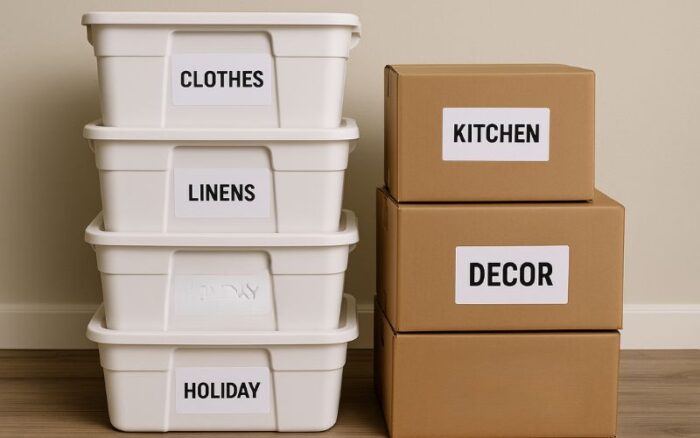Downsizing is inevitable. Eventually, you’ll need to go through all the things your loved one has accumulated over their lifetime.
Cleaning out a house full of stuff sounds exhausting and intimidating, but it really doesn’t have to be. It could be an opportunity to relive significant memories and learn more about your parent or spouse’s life.
For many, downsizing means moving into a smaller home, studio apartment, or assisted living community. That transition can feel like a daunting task, but with patience and a plan, it becomes easier.
Downsizing Quick-Glance Checklist
Keep
- Sentimental items with deep meaning or family heirloom value
- Necessary documents: wills, medical records, financial paperwork
- Essentials that will be used regularly in the new home
- A few favorite books, DVDs, or photos that truly matter
Sell
- Household items in good condition (pots, pans, kitchen gadgets, utensils)
- Furniture that won’t fit in a smaller space
- Collectibles, bookshelves, or material possessions with monetary value
- Use Craigslist, eBay, Facebook Marketplace, or hold a garage sale/yard sale for extra cash
Donate
- Clothing, linens, and items in good condition
- Appliances, décor, or furniture that a local charity, Goodwill, or Salvation Army will accept
- Non-essential household items that don’t hold sentimental value
Toss
- Broken items, expired paperwork, or clutter with no use
- Worn-out clothing or household items not in good condition
- Large piles of trash or purges that may require a dumpster rental
5 Tips to Downsize Keepsakes and Mementos
Sorting through meaningful keepsakes and mementos is a tough job. But even though it’s time-consuming, deciding what to keep and what to get rid of is a meaningful part of the downsizing process.
If the process of downsizing is too much for you to tackle alone, consider utilizing the services of a senior move manager.
We’ve got five tips to make this project less stressful and more enjoyable.
Pace Yourself

Going through a lifetime of essential memories isn’t something you can get done in a weekend or even a week. Be realistic and take the time to make thoughtful decisions.
Pick one box or collection of items and go through piece by piece without rushing. After you finish with that box, start on another. Using storage bins to sort items into categories like “keep,” “donate,” “sell,” and “trash” can help you stay organized and reduce clutter.
Help Your Loved One Feel in Control
If your loved one can take part, this is an excellent way for them to feel more in control of the moving and decluttering process.
Going through their own belongings, sharing stories, and deciding what to do with each item allows them to take charge. They’ll feel good about making these decisions themselves rather than leaving it to someone else.
This is especially true for sentimental items or family heirlooms, which often carry strong sentimental value. When your loved one decides where those items go, it lifts a burden and helps them embrace the transition to a new home or smaller space.
Remember Special Moments

Looking at keepsakes and mementos often brings up memories of significant life events. Take time to reminisce over special moments, hear touching stories, and share meaningful conversations.
It’s also a chance to create an inventory of items that hold sentimental value, things like photo albums, bookshelves filled with favorite titles, or even kitchen gadgets and utensils that were part of family traditions. These moments are just as important as the physical belongings.
Gift Family Heirlooms
If your loved one has a chance to gift meaningful family keepsakes and furniture, they’ll get to see how happy those mementos make family and friends. Plus, there won’t be any confusion over who should get what.
For less special items, you could take a picture of them, write a brief description of their story or history, and share that with family members. Then, donate or sell the item knowing that you’ve preserved the memory.
There are many ways to pass along unwanted items:
- Host a garage sale or yard sale for extra cash
- List things on Craigslist, eBay, or Facebook Marketplace
- Donate to a local charity, Goodwill, or Salvation Army if items are still in good condition
These options can help clear clutter while giving material possessions a second life.
VIDEO: Downsizing Sentimental Items Before a Move
Use Key Questions to Decide Whether to Keep, Give Away, or Sell

- Is this item regularly used? Has it been used in the past year?
- Does it truly enhance the quality of your loved one’s life?
- Would this item physically fit in their smaller living space and future lifestyle?
- Does it have a significant dollar value?
If something is not essential and won’t fit in the new space, it may be better to donate it or toss it in the trash or even a rented dumpster. This applies to everyday household items like pots, pans, DVDs, or paperwork that isn’t part of essential documents.
Bottom Line
It’s tough deciding what to do with your loved one’s prized possessions. Taking your time and working with your parent or spouse makes the experience more rewarding. De-cluttering well before a move also relieves the stress that all that extra stuff causes.
By organizing with storage solutions, donating to local charities, and selling unwanted items, you can turn what feels like a daunting task into a smoother transition. Downsizing frees up space, reduces expenses, and makes room for the essentials that matter most in their new home.
Common Questions About Downsizing
Downsizing comes with numerous decisions, and caregivers often wonder where to start or what to avoid. Here are answers to some of the most common questions families ask when helping a loved one through this transition.
The best way is to start small. Don’t try to tackle the whole house at once; it can feel like a daunting task. Begin with one box, a single closet, or one corner of the living room. Use storage bins to sort items into piles: keep, donate, sell, or trash. Small wins build momentum.
A promising sign is when your loved one is moving into a smaller home, studio apartment, or assisted living community. It’s also time if the house feels like too much room to manage, the upkeep is becoming a burden, or the household expenses are more than they can handle. Downsizing lightens the load and makes the transition easier.
Go slow and steady, don’t rush. Make an inventory of what’s truly essential and what has sentimental value. Encourage selling unwanted items through Craigslist, eBay, or Facebook Marketplace, or even hosting a garage sale or yard sale for extra cash. Donate items in good condition to a local charity, Goodwill, or Salvation Army. Storage solutions can keep everything organized as you sort.
Please don’t rush through sentimental items or family heirlooms; your loved one may want to share stories before letting them go. Don’t forget to set aside important documents and paperwork. And try not to move clutter into the new space. Downsizing is about keeping only what’s needed and meaningful, not carrying the burden of material possessions into a smaller home.
About the Author

Amie Clark is a senior care expert with over 25 years of experience in aging services, caregiving, and senior housing. She combines her professional expertise and personal caregiving insight to help families navigate aging, long-term care, and end-of-life decisions with clarity and compassion.












